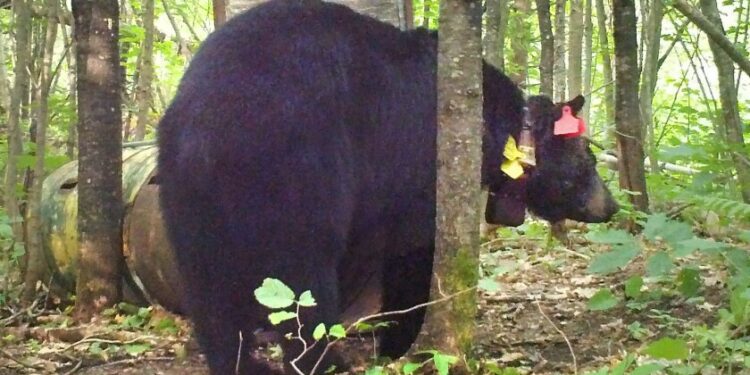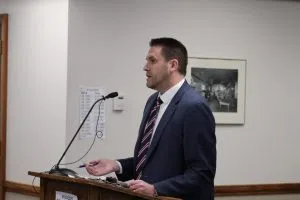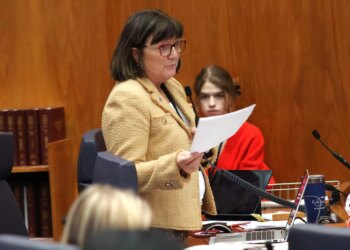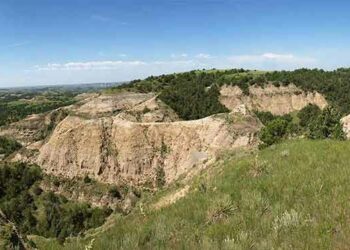BISMARCK – North Dakota’s deer bow season opens at noon Aug. 30 and continues through Jan. 5, 2025, the Game and Fish Department said Thursday, Aug. 22, in a reminder.
Bowhunters can
buy a license online
through the North Dakota Game and Fish Department website at
gf.nd.gov
or at vendors linked to the department’s
online licensing system
.
Hunters should plan accordingly and allow for time to receive their tag in the mail, as the tag will arrive by postal mail and not over the counter while the customer waits. That applies while purchasing a bow license at a license vendor, or at the Game and Fish Department’s main office in Bismarck. The bow tag will be mailed the next business day after the license is purchased.
All archery hunters must have a bow tag in possession before hunting.
Hunters should refer to the
2024 deer hunting guide
for season information and regulations.
– staff report
NDGF highlights CWD proclamation
BISMARCK – Big game hunters in North Dakota should note the 2024
chronic wasting disease proclamation
for baiting and transportation requirements for deer, elk and moose as a precaution against the spread of the fatal brain disease.
Noteworthy items include:
Deer gun hunting unit 2B is removed from the list of units where
baiting is restricted
after the minimum sampling requirement was met with no positive detections.No new units have been added to the baiting restriction list for 2024-25.Hunters are prohibited from transporting into North Dakota the whole carcass or parts, except the lower-risk portions, of deer, elk, moose or other members of the cervid family harvested outside of North Dakota.
Game and Fish will conduct
surveillance of the state
by region on a four-year rotation. This year, the CWD surveillance effort will consist of deer gun units in northeastern North Dakota. Outside of this area, hunters can still have their animal tested by taking it to a Game and Fish district office, any deer head collection site (primarily located in the surveillance area) or using a
mail-in self-sampling kit
. A unit outside the annual surveillance zone is still eligible to have a baiting restriction removed if the sampling goal is met, or can be added as a restricted unit if a positive is found.
– staff report
NDGF lifts WMA camping restrictions for holiday
BISMARCK – The North Dakota Game and Fish Department will lift the Tuesday-Wednesday camping restriction on state wildlife management areas for the Labor Day holiday week.
The removal of the restriction will allow overnight camping Sept. 3-4 on those WMAs that otherwise have the two-day restriction in place.
A complete list,
including other WMA regulations
, is available on the Game and Fish website at
gf.nd.gov
.
– staff report
DNR: Don’t shoot marked research bears

Radio-collared research bears in Minnesota are marked with distinctively large, colorful ear tags.
Contributed / Minnesota DNR
ST. PAUL – The Minnesota bear hunting season opens Sunday, Sept. 1, and the Department of Natural Resources once again is asking hunters to avoid shooting marked research bears. These bears are marked with distinctively large, colorful ear tags and wear radio collars.
Researchers with the Minnesota DNR are monitoring 48 radio-collared black bears across the state, especially in bear hunting zones 27, 45, and parts of the no-quota zone. Most of the radio-collared bears live in or near the Chippewa National Forest, Camp Ripley Military Reserve, the Pillsbury State Forest and the Brainerd-Baxter area. However, the bears also range widely from these sites.
“We ask hunters to avoid shooting these valuable research bears,” Andy Tri, Minnesota DNR bear research scientist, said in a statement. “These collared bears give us much of the data we use in bear management and are most valuable to us when they are collared for multiple years. Thank you to hunters who have opted to not take collared bears in past years and hunters who will choose to not harvest collared bears this season.”
A key to the research is looking at year-to-year changes in natural food supplies and how those changes affect individual bears in terms of their habitat use, physical condition, denning, reproduction and interactions with people. The research is not designed to evaluate mortality from hunting. Trapping new bears every year to replace the ones killed cannot substitute for long-term data on individual bears.
All the collars the Minnesota DNR uses in this research have GPS units. The GPS coordinates are either uploaded to a satellite or stored in the collar and downloaded by DNR researchers when they visit the bears in their dens. Each bear provides several thousand data points per year.
The bear’s coat often hides the collar, especially in the fall, and most of the collars are black. But all collared bears have large (3×2 inch), colorful ear tags. The tags should be plainly visible on trail cam photos or when a bear is at a bait. Example photos of collared bears with ear tags and a summary of pertinent research findings can be found online under the link “Importance of Radio-collared Bears” on the
Minnesota DNR bear management page
at
mndnr.gov/hunting/bear
.
DNR officials recognize hunters might not be able to see a radio collar or ear tags in some situations. For this reason, taking a bear with a radio collar is legal; however, pausing briefly to get a clear view of the bear’s head would reveal whether it has large ear tags, which indicates that it is collared.
Most collared bears have a small, implanted heart monitor under the skin on the left side of the chest. It looks like a small, silver capsule that is approximately the width of a paper clip. This contains valuable information stored in memory. Hunters who take a collared bear and find this device while skinning the bear are asked to submit it with the collar.
Hunters may see bears with very small ear tags (1x¼ inch). These bears are not collared and may be part of other ongoing research projects. It is legal to take a bear with small ear tags. These bears can be treated as any other bear, but the DNR asks hunters to report the tags.
Hunters who shoot a collared or ear-tagged bear are asked to call the Minnesota DNR Wildlife Research Office in Grand Rapids at (218) 328-8879 or (218) 328-8874 to report it and coordinate the pickup or dropoff of the collar and heart monitor, if applicable.
– staff report
Federal duck stamp required Sept. 1
BISMARCK – A federal duck stamp is required for waterfowl hunters 16 and older beginning Sept. 1, the North Dakota Game and Fish Department said in a reminder. Waterfowl includes ducks, geese, swans, mergansers and coots.
This year’s 2024-25 federal duck stamp is available for electronic purchase through the Game and Fish website at gf.nd.gov, or license vendors registered with the department’s licensing system.
As a result of the Duck Stamp Modernization Act, the electronic stamp is now valid for the entire waterfowl hunting season. A physical stamp will be mailed in March 2025 to anyone who purchases the e-stamp.
Physical stamps can be purchased at many U.S. Postal Service offices or the Amplex website, and Amplex should be used for hunters wanting to support conservation by purchasing extra duck stamps.
The federal duck stamp costs $25. An additional $4 processing fee is added.
– staff report
BISMARCK – Migratory bird hunters of all ages need to register with the Harvest Information Program (HIP) before hunting ducks, geese, swans, mergansers, coots, cranes, snipe, doves and woodcock. Hunters must register in each state they are licensed to hunt.
Hunters can HIP certify when purchasing a license by visiting the North Dakota Game and Fish Department website at gf.nd.gov.
Those who registered to hunt during the spring light goose conservation order in North Dakota do not have to register with HIP again, as it is required only once per year.
HIP registration is a cooperative program designed to determine a sample of hunters to measure harvest of migratory birds for management purposes.
– staff report
CO candidates graduate from Academy
ST. PAUL – Eighteen people who’ve trained since late April to become Minnesota DNR conservation officers took a step closer to achieving their goal recently, when they graduated from the 23rd CO Academy. The 18 candidates now will spend the next several months training throughout the state with experienced conservation officers.
The new officers will complete field training and be in their assigned stations in early December.
The officers have a wide variety of backgrounds and experiences. Some have previous law enforcement experience, others are veterans and six came to the DNR through the CO Prep program, which provides a pathway for anyone with at least a two-year degree to become a conservation officer.
“Everyone’s reason for becoming a conservation officer is unique, but the common thread that joins all of these individuals is a commitment to protecting Minnesota’s people and natural resources and a desire to ensure future generations have the same or better opportunities than we have today,” Col. Rodmen Smith, director of the DNR Enforcement Division, said in a statement. “I’m excited for these folks to join the team and continue our proud, 137-year tradition.”
The Conservation Officer Academy prepares new officers to occupy vital roles in the communities they serve. During the Academy, recruits are trained in all aspects of being a conservation officer and learn from experienced officers and other experts on a wide variety of topics, including education/outreach, fish and wildlife laws, patrol procedures and environmental enforcement. Cadets are tested each week and put through practical scenarios that reflect what they’ll encounter in the field. During the field training portion of their preparation, cadets work throughout the state with experienced officers before they head for the permanent stations.
Each of the graduates was chosen from among hundreds of applicants and underwent rigorous examinations, psychological profiles, and background checks before beginning at the Academy.
– staff report
PF, DNR join forces for hunter recruitment
ST. PAUL – The DNR and Pheasants Forever have teamed up to offer the Hunter Mentor Challenge, inviting Minnesota hunters to take someone hunting who has never hunted or hasn’t hunted for a few years.
After their hunt, participating Minnesota hunters and their mentees will have the chance to win a limited-edition Pheasants Forever prize.
The program is open to all types of hunting in Minnesota that are legal and in-season – including, but not limited to pheasants, grouse, waterfowl, deer, squirrels and wild turkey (applies to fall and spring turkey seasons). Experienced hunters can invite a new hunter of any age, if they have the proper license/tag necessary and either hunter’s safety or apprentice hunter validation.
Participation is simple: Visit the Minnesota DNR page on the Pheasants Forever website –
pheasantsforever.org/mndnr
– and
take the pledge
. After taking the pledge, hunters are asked to bring a novice or returning hunter on a hunt during upcoming hunting seasons and snap a picture or short video during the hunting trip. The last step is to submit contact information, a short summary of their hunt and a photo or video on the submission page to be entered for prize giveaways. All online entries must be received by June 30, 2025.
For more information, checkout the
Minnesota DNR take a friend hunting webpage
at
mndnr.gov/gohunting/take-friend-hunting.html
.
– staff report
Minnesota deer lottery apps due Sept. 5
ST. PAUL – Minnesota firearm and muzzleloader hunters who want to harvest antlerless deer in a deer permit area designated as antlerless permit lottery this hunting season must buy their license by Thursday, Sept. 5, the DNR said in a reminder. Hunters who purchase their license on or before this date are automatically entered into the lottery for the deer permit area or special hunt area they declare.
Successful applicants will receive a postcard in the mail authorizing them to take an antlerless deer using their regular license in that antlerless permit lottery area. No application is needed to take antlerless deer in permit areas with either sex, two-deer limit, three-deer limit or five-deer limit designations. Hunters are reminded that DPAs 235 and 251 went from either-sex to lottery this year.
Hunters who want to participate in special firearm or muzzleloader deer hunts also need to apply for permits that are issued through a lottery. That application deadline is also Sept. 5.
On the web:
– staff report
Source link : http://www.bing.com/news/apiclick.aspx?ref=FexRss&aid=&tid=66c9aa6cd71647c98e038c4502e5daec&url=https%3A%2F%2Fwww.grandforksherald.com%2Fsports%2Fnorthland-outdoors%2Foutdoors-notebook-north-dakota-archery-deer-season-opens-aug-30&c=3183486419124355655&mkt=en-us
Author :
Publish date : 2024-08-21 13:00:00
Copyright for syndicated content belongs to the linked Source.







